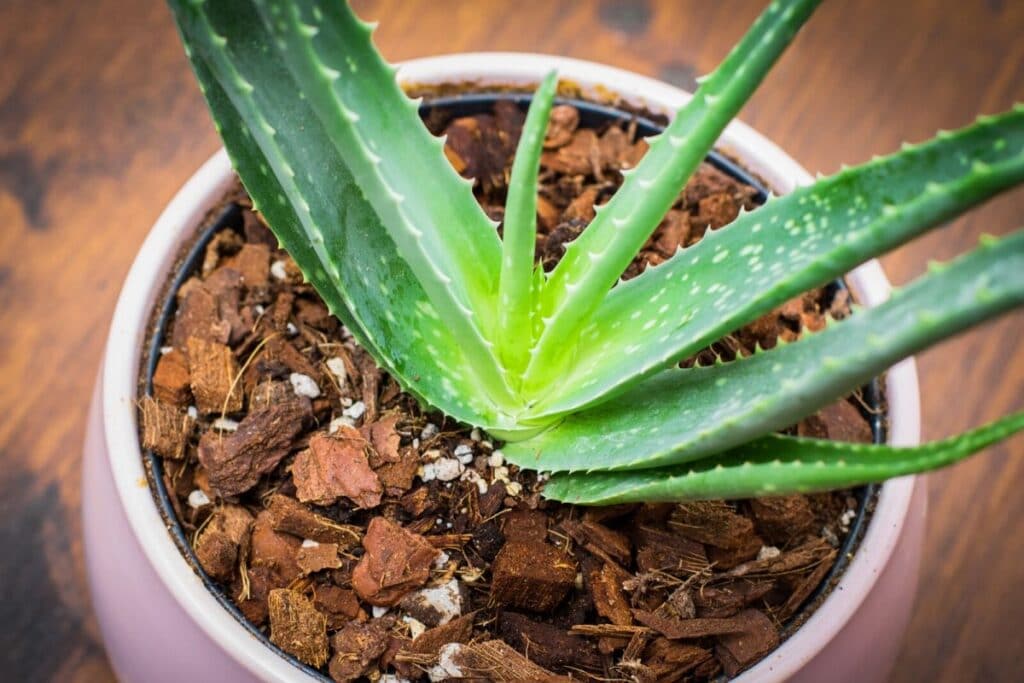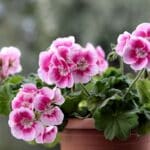Aloes are a widely grown species of ornamental plants. They are prized among gardeners for their thick, fleshy foliage, and brilliantly colored inflorescence.
What Plant is an Aloe?
Aloes got their name from the Arabic word “Alloeh” which means “shining bitter substance”, pertaining to the aloe gel. These succulent plants originated in the Arabian Peninsula. They are evergreen perennials that grow in tropical, subtropical, and arid climates where they are found thriving in rocky cliffs and coastal areas (1).
The leaves of many aloe species are thick and fleshy, and arranged in a rosette. They may vary in color which ranges from grey to bright green with pinkish hues. Some varieties have mottled patterns too (2).
Only mature aloe plants bloom. It takes about 4 years for an aloe plant to mature and bloom, but the long wait is worth it because the reward is a tall, beautiful cluster of brightly colored flowers arising from the top of the already striking rosette leaves (2).
What are the Best Types of Aloe?
The aloes are a big group, its members may vary from one-inch tall plants to 40-ft tall ones. Here, we will talk about some popular species of aloe that will make a nice addition to your garden and indoor plant set up.
1. Aloe Vera (Aloe barbadensis)
When you think of Aloe vera plant, you probably picture this plant in your mind. Also called Barbados Aloe, Chinese Aloe, Aloe barbadensis Miller, and True Aloe, Aloe vera is the most common aloe species grown in cultivation, especially in many tropical areas as a tropical plant. The species name “vera” comes from a Latin word which means “true” or “genuine” (3).
Aloe vera is a native plant of the South West Arabian Peninsula. The aloe vera plants are evergreen succulents with light green leaves that may have white spots, depending on the variety.
The leaves are adorned with pale spines running along its margins (3). A gel made from aloe leaves is used by many to treat sunburns, light burns, and skin irritations.
2. Stone Aloe (Aloe petricola)
Stone Aloes are evergreen succulents native to South Africa. The word “petricola” is of Latin origins, which means “stone loving”. As the name implies, stone aloes are perfect for stony landscapes.
Stone Aloe blooms in mid-summer to a tall, tightly packed raceme that sometimes branches 3-5 times, depending on the age of the plant. The flower buds are red to orange in color and open into creamy yellow flowers. The flowers are abundant in nectar and pollen, attract bees and nectar-feeding birds (4).
3. Cape Aloe (Aloe ferox)
Aloe ferox, commonly known as cape aloe, are showy, evergreen succulents native to South Africa. The name “ferox” means fierce or warlike, referring to its spiny margins. Cape Aloe is also known as Bitter Aloe, Red Aloe, and Tap Aloe.
These indoor plants are quite large, growing up to 6-9 ft tall and 3-5 ft wide. The aloe leaves are blue-green and lance-shaped with a slight pinkish tinge at the tips.
Reddish brown spines can be found on the underside of the leaves and along the margins. The leaves form a compact rosette along a single stem and remain when dried, forming a drooping structure called “petticoat” (4).
Cape Aloe grows in well-drained soil and enjoys full sun. These plants will be a perfect addition to rock gardens, coastal gardens, or Mediterranean gardens. Cape Aloe is used in making bitter aloe, a purgative medication.
4. Coral Aloe (Aloe striata)
These perennial succulents are native to South Africa, often found on rocky coastal areas. Coral Aloe plants are stemless and feature a rosette of broad, flat leaves that are pale grey-green in color.
In full sunlight, the leaves turn on a pinkish hue along the margins. Unlike the Stone Aloe and Cape Aloe, coral aloes do not have spines on its leaves. Slight narrow stripes run along their leaves, hence the species name “striata”.
5. Candelabra Aloe (Aloe arborescens)
Aloe arborescens, also known as Candelabra Aloe, Torch Aloe or Krantz Aloe, is an evergreen succulent famous for its brilliantly red flowers and impressive foliage. The species name “arborescens” means “tree-like”, referring to its stem-forming habit. Candelabra Aloe is endemic to south eastern parts of South Africa where they grow in rocky areas called “krantz” (5).
Candelabra Aloe is multi headed succulent shrubs. They grow up to 6-10 ft high with striking grey-green leaves arranged in a rosette. The lanceolate leaves have prominent pale-yellow spines along their margins. Under full sunlight, the leaves may take on a pinkish hue.
Candelabra Aloe has variegated varieties. They are also known to be promiscuous hybridizers, with several hybrids available.
How Do You Take Care of Aloe Plants?
Here are the most common knowledge you need to know when it comes to learning how to proper care for aloe plants:
Does It Need Sunlight?
Most aloe species love the sun. They need bright light but can tolerate partial shading. When growing aloes indoors, it is important to place them in areas where they can get plenty of enough light, ideally bright, indirect light. Ideally, a south-facing window with a bright spot would be perfect. Some aloe species will develop rot when kept in shaded areas for too long.
Introducing indoor aloes outside should be done gradually to avoid burning. Some species of aloe will develop a pinkish tinge on their leaves with prolonged exposure to artificial light.
What is the Optimum Temperature and Relative Humidity for Aloes?
Aloes are generally hardy to heat and perform well with low humidity. The optimal temperatures for aloe ranges from 65 – 75 oF (18 – 21oC) during the day, and no lower than 60oF (15oC) at night. Some species are hardy to cold temperatures and can tolerate up to 20 – 50 oF (-6.7 – 10oC) (6).
Water
As with all succulents, aloes are perfectly suited for dry climates. Allow the soil to completely dry before watering again to avoid rot. Aloes are drought tolerant and some species can even tolerate prolonged drought conditions, but they look a lot better with little water (6).
Fertilizer
Because of its short root system, aloe plant grows best in a well draining potting mix of two parts sand to one part gardening soil. Aloes generally do not require a lot of fertilizer but if you ever decide to add fertilizer to your aloe, limit the application to the growing season. Fertilize with diluted general purpose or phosphorus-heavy fertilizer (6).
Repotting
Aloe plants typically do not require frequent repotting and prefer to be slightly root-bound. Repot only when the plant has outgrown its current container or when the soil has become depleted of nutrients.
Choose a slightly larger pot with adequate drainage holes and fresh, well-draining soil. Repotting is best done in spring when the plant is actively growing.
Pruning
Minimal pruning is necessary for aloe plants. Gently remove any dead or yellowing leaves by gently pulling them away from the base of the plant. Trim off any damaged or diseased parts with sterile pruning shears to maintain the plant’s appearance and health.
Be cautious when handling aloe plants, as their leaves contain a gel-like sap that can cause skin irritation.
Propagation
Aloe plants can be propagated easily from offsets, or “pups,” that grow at the base of a mother plant. Wait until the offsets are several inches tall before carefully removing them from the parent plant. Plant the offsets in their pots with well-draining soil and water sparingly until they establish roots. Propagation is best done in spring or early summer when the plants are actively growing.
FAQs
Do aloe plants need direct sunlight?
Aloe plants prefer bright, indirect sunlight but can also tolerate some direct sun light. However, intense, prolonged sunlight may cause the leaves to become scorched or turn brown.
Should I cut the brown tips off my aloe plant?
If your aloe plant has brown tips, it’s usually a sign of dehydration or sunburn. Trimming off the brown tips can improve the plant’s appearance, but it’s essential to address the underlying issue by adjusting watering and natural light conditions to prevent further damage.
What does an overwatered aloe plant look like?
An overwatered aloe plant may develop soft, mushy leaves and show signs of root rot, such as wilting or yellowing foliage. The plant’s leaves may also appear translucent or waterlogged.
How often should you water an aloe plant?
Aloe plants are drought-tolerant succulents and prefer infrequent watering. Water the plant thoroughly when the soil is dry completely to the touch, typically every 2-3 weeks, depending on factors such as temperature, humidity, and pot size. Ensure that the current pot has proper drainage to prevent water from accumulating at the bottom, which can lead to root rot.
References
Reference List
(1) Surjushe, A., Vasani, R., & Saple, D. G. (2008). Aloe vera: a short review. Indian journal of dermatology, 53(4), 163–166. https://doi.org/10.4103/0019-5154.44785
(2) Kativu S. (2008) “Aloe L. [Family ALOACEAE]”. Flora Zambesiaca 12(3), 48.
(3) “Aloe vera (true aloe)”. CABI. (online). Available at https://www.cabi.org/isc/datasheet/4192#tosummaryOfInvasiveness
(4) Aubrey A. (2001). “Aloe ferox”. PlantZAfrica, South Africa National Biodiversity Institute. Available at http://pza.sanbi.org/aloe-ferox
(5) Hankey A, Notten A (2004). “Aloe Arborescens”. PlantZAfrica, South Africa National Biodiversity Institut. Available at http://pza.sanbi.org/aloe-arborescens
(6) Adams R. (2015). Aloes A to Z. Te Puke, New Zealand.
Close
*Photo by lsantilli/depositphotos







